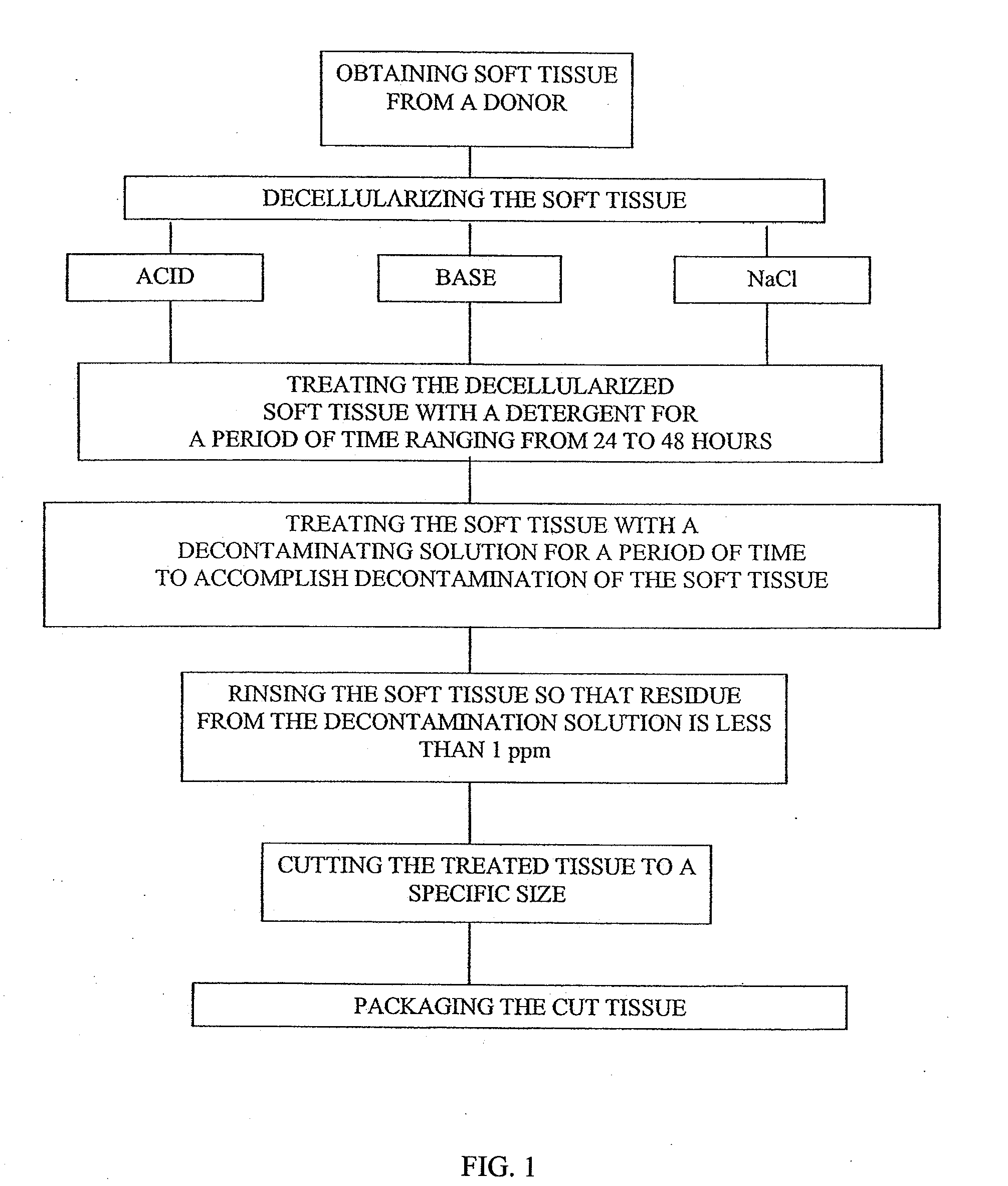Processing soft tissue, methods and compositions related thereto
a soft tissue and allograft technology, applied in the field of allograft soft tissue treatment, can solve the problems of narrow therapeutic window between adequate immunosuppression and toxicity, significant risk of tissue rejection associated with transplantation, infection threat, etc., and achieve the effect of long-term durability and function
- Summary
- Abstract
- Description
- Claims
- Application Information
AI Technical Summary
Benefits of technology
Problems solved by technology
Method used
Image
Examples
example 1
[0083]Dermis tissue is cut to a rectangular shape, the subcutaneous fat is removed and the tissue placed in a container with an aqueous solution of a weak acid, e.g., acetic acid. The aqueous acetic acid solution is at a concentration of 0.1 Molar and at pH 2.9. The tissue is immersed in the acetic acid solution for 2 to 24 hours, preferably12 hours and is agitated and maintained at room temperature (15° C. to 30° C.). After the acid wash period, the acid solution is discarded and the skin washed in isotonic saline for three rinses of twenty minutes each to remove the cells and cell fragments. The saline is discarded after each rinse. Finally the skin is rinsed in a neutral pH buffer, e.g., phosphate buffered saline at pH 7.4 until the skin stabilizes at pH 7.4 (measured by testing the skin with pH paper contacting the wet skin).
[0084]Other weak acids that may be used are 0.1 Normal boric acid at pH 5.2 or 0.1 N citric acid at pH 2.2.
example 2
[0085]Dermis tissue is cut to a rectangular shape, the subcutaneous fat is removed and the tissue placed in a container with an aqueous solution of a weak base, e.g., ammonium hydroxide. The ammonium hydroxide is at a concentration of 0.1 Molar and at a pH of 11.1. The tissue is immersed in the ammonium hydroxide solution for 12 hours (range 2 to 24 hours) and is agitated and maintained at room temperature (15° C. to 30° C.). After the alkaline wash period, the base solution is discarded and the skin washed in isotonic saline for three rinses of twenty minutes each. The saline is discarded after each rinse. Finally the skin is rinsed in a neutral pH buffer, e.g., phosphate buffered saline at pH 7.4 until the skin stabilizes at pH 7.4 (measured by testing the skin with pH paper contacting the wet skin).
[0086]Other weak bases that may be used are 0.1 Normal sodium bicarbonate at pH 8.4 or 0.1 N sodium carbonate at pH 11.6.
[0087]Another method of decellularizing the dermis tissue is sh...
example 3
[0088]Sodium Chloride (NaCl) solution at a concentration of 0.1-10M, preferably about 1M with a pH ranging from 5.0-9.0, preferably 6.8-7.2, and is agitated at a speed of 65 rpm on an orbital shaker for 1-96 hours, preferably 12 hours to a maximum of 48 hours. After 12 hours, the container holding the skin is checked to ascertain if the epidermal layers have been sloughed off. If not, the container is inspected every 2 hours until the epidermis has sloughed off. The dermis is then removed and placed on a cutting surface with the epidermal side up and any remaining epidermal layer is removed and discarded as well as any remaining hairs. Optionally, the remaining dermis pieces are replaced in the tissue flasks, filled with sterile water and agitated on the orbital shaker for 15 minutes. The sterile water is refreshed and the rinse procedure is repeated one more time for a total of two rinses.
[0089]After decellularization is performed by Examples 1, 2 or 3, the final rinse is complete,...
PUM
 Login to View More
Login to View More Abstract
Description
Claims
Application Information
 Login to View More
Login to View More - R&D
- Intellectual Property
- Life Sciences
- Materials
- Tech Scout
- Unparalleled Data Quality
- Higher Quality Content
- 60% Fewer Hallucinations
Browse by: Latest US Patents, China's latest patents, Technical Efficacy Thesaurus, Application Domain, Technology Topic, Popular Technical Reports.
© 2025 PatSnap. All rights reserved.Legal|Privacy policy|Modern Slavery Act Transparency Statement|Sitemap|About US| Contact US: help@patsnap.com



